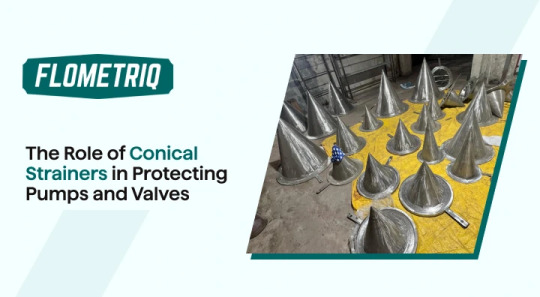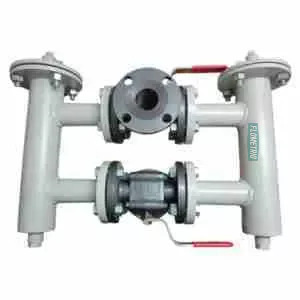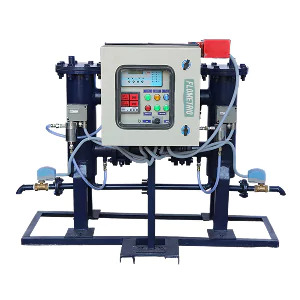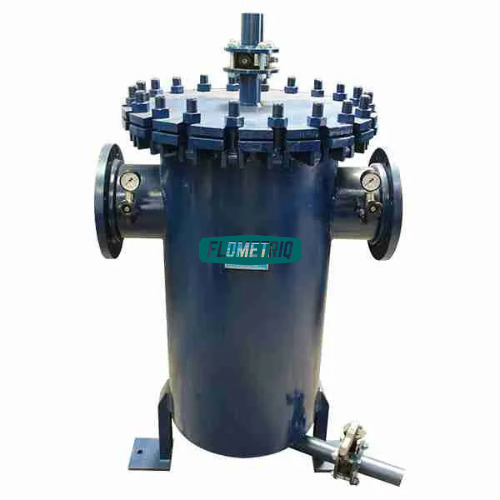Flometriq is a top industrial filter manufacturer offering the best custom filtration solutions for various industries with quality, reliability, and performance.
Don't wanna be here? Send us removal request.
Text
The Importance of Duplex Strainers in Oil Refineries and Chemical Plants

In high-stakes industrial environments like oil refineries and chemical processing plants, even a few minutes of downtime can lead to costly delays or equipment damage. That’s why duplex strainers play such a critical role; they help maintain continuous flow, protect sensitive equipment, and reduce maintenance frequency.
Let’s explore why duplex strainers are indispensable in these sectors, how they work, and how to select the right one for your process.
What is a Duplex Strainer?
A duplex strainer, also known as a dual basket strainer, is an industrial filtration device made up of two separate chambers, each containing a removable basket filter. These baskets trap debris, rust, scale, and other particles from liquids or gases flowing through pipelines.
The standout feature? You can switch between baskets without stopping the flow. This makes them ideal for operations that require round-the-clock, uninterrupted processing, such as oil, gas, chemical, and power industries.
Why Are Duplex Strainers Important in Oil Refineries?
Oil refining involves high temperatures, pressure, and fluids with suspended solids. If these particles aren’t filtered, they can clog or damage key components like:
Pumps
Valves
Heat exchangers
Flow instrumentation
Here’s how duplex strainers solve these problems:
1. Enable Uninterrupted Operation
With one basket filtering and the other on standby, maintenance can be performed without stopping the process, saving time and avoiding costly shutdowns.
2. Shield Critical Equipment
By capturing harmful particles early, duplex strainers protect downstream equipment and extend their lifespan, reducing wear and tear.
3. Tolerate Harsh Conditions
Made from robust materials like stainless steel or alloy steel, these strainers are built to handle high-pressure and high-temperature environments typical of refineries.
4. Minimize Downtime
When one basket clogs, the system can instantly switch to the second one, allowing the first to be cleaned without halting operations.
5. Improve Reliability
Filtering out solids prevents erosion and corrosion, keeping systems efficient and extending maintenance intervals.
Importance of Duplex Strainers in Chemical Plants
Chemical plants often process corrosive, toxic, or highly reactive substances. Maintaining fluid purity is essential to:
Ensure product quality
Prevent unsafe reactions
Maintain equipment integrity
Comply with safety regulations
Duplex strainers are crucial here because they:
Prevent System Blockages
Tiny particles can interfere with reactions, especially in catalytic processes. Duplex strainers remove these impurities before they reach reactors or sensitive components.
Reduce Corrosion Risks
They filter out contaminants like rust and scale that could accelerate corrosion in processing equipment.
Support Safety & Compliance
By maintaining pressure levels and flow consistency, these strainers help plants avoid overpressures, leaks, or hazardous events while staying within environmental safety norms.
Key Advantages of Duplex Strainers in Industrial Settings
Still wondering why duplex strainers are so popular in heavy-duty applications?
Here’s what makes them stand out:
No Process Interruption: Manual or automatic switching ensures non-stop filtration.
High Flow Capacity: Designed to handle industrial-scale volumes with minimal pressure drop.
Corrosion-Resistant Build: Stainless steel, bronze, or cast iron options suit different fluid chemistries.
Versatile Use Cases: Effective with water, fuel, solvents, lubricants, and aggressive chemicals.
Custom Options Available: Choose from ASME-certified, jacketed, or high-pressure designs.
Enhanced Filtration: Mesh screens or perforated baskets capture particles as small as 10 microns.
How to Choose the Right Duplex Strainer?
To select the best-fit duplex strainer for your plant, consider:
1. Flow Rate & Operating Pressure
Pick a strainer that can handle your system’s peak flow without bottlenecks.
2. Mesh or Basket Size
Choose a mesh size based on the type and size of particles you need to remove.
3. Material Compatibility
Match the strainer body and basket materials with your fluid’s chemical properties and temperature range.
4. Ease of Maintenance
Look for features like lever-operated valves, sight glasses, and pressure differential gauges for safe, smooth operation.
Final Thoughts
Though small in size, duplex strainers have a massive impact on plant reliability, safety, and cost-efficiency. Whether you operate a refinery or a chemical manufacturing plant, using the right duplex strainer can mean the difference between smooth operations and expensive downtime.
For more information, please visit
0 notes
Text
The Role of Conical Strainers in Protecting Pumps and Valves

Protecting pumps and valves from debris during system startup ensures reliable operation and avoids costly downtime. New or modified pipelines often carry leftover construction materials—like rust, welding slag, and scale—that can seriously damage sensitive components. This is where conical strainers play a critical role.
What Are Conical Strainers and Why Are They Important?
Conical strainers (temporary cone strainers )are cone-shaped mesh or perforated metal filters placed between pipe flanges. They're designed for short-term use during pipeline systems' commissioning or startup phase.
When fluid flows through a newly installed system, it can carry construction debris that may damage pumps, control valves, and meters. Conical strainers capture this debris early on, offering essential protection when the system is most vulnerable.
Why Startup Debris Is Dangerous
New pipeline systems often contain:
Welding slag
Rust particles
Pipe scale
Jointing compound
These materials can lead to:
Abrasion and erosion of the pump and valve components
Clogging of narrow passages and filter elements
Seizing of moving parts due to large debris
Reduced performance and internal leakage
How Conical Strainers Work
The effectiveness of conical strainers lies in their design. Inserted between two pipe flanges, their cone shape offers a large surface area for filtering. As the fluid passes through, solid contaminants get trapped inside or outside the cone—depending on the orientation.
This setup ensures:
High filtration efficiency
Low pressure drop
Easy debris collection and removal
Benefits of Using Conical Strainers
Using a conical strainer during startup provides several advantages:
Protects expensive components from early failure
Extends equipment lifespan by preventing wear
Reduces maintenance costs and emergency interventions
Prevents unplanned downtime
Improves overall system reliability
Material Options:
Stainless Steel 304 / 316 (corrosion resistance)
Carbon Steel
Monel and other specialty alloys
Key Specs to Consider:
Mesh/perforation size (determines what particles are captured)
Open area ratio (impacts flow capacity)
Installation Best Practices
To maximize performance:
Orientation: Install the cone upstream or downstream based on system needs.
Sizing: Match pipe diameter, flange rating, and bolt circle.
Sealing: Use appropriate gaskets to ensure leak-free operation.
Temporary Use and Maintenance
Most conical strainers are designed for short-term use. Once the system has been flushed and debris removed, the strainer should be taken out to prevent pressure drop and clogging.
To remove:
Isolate the section
Depressurise the line
Unbolt the flanges
Remove the strainer carefully.
Conical vs. Permanent Strainers
Use Conical Strainers for temporary protection during startup.
Use Permanent Strainers (like basket or Y-type strainers) for ongoing filtration needs.
Industries That Use Conical Strainers
Conical strainers are widely used in industries where clean fluid flow is essential from the start:
Oil & Gas
Chemical Processing
Power Generation
Marine
Water Treatment
Food & Beverage / Pharmaceutical
Pulp & Paper
Final Thoughts: Start Clean, Stay Efficient
A smooth startup sets the foundation for reliable operations. Conical strainers are a cost-effective, temporary filtration solution that protects your pumps, valves, and instrumentation from damaging debris. They help avoid unexpected downtime and reduce long-term maintenance costs.
If you're commissioning a new system, don’t overlook this small but powerful piece of equipment. It’s been the smart way to protect your bigger investments from day one.
For more information, please visit.
#conical suppliers#conical strainers suppliers#conical strainers manufacturers#duplex strainers manufacturers
0 notes
Text
Duplex Strainers vs. Simplex Strainers: Pros, Cons, and Applications
Selecting the right strainer type, Simplex or Duplex, is crucial for building an efficient and reliable liquid filtration system. Both are designed to capture solid contaminants and protect downstream equipment, but their configurations, operational efficiency, and maintenance differ.
What is a Simplex Strainer?
A simplex strainer (also known as a single-basket strainer) is a filtration device with one basket designed to remove solid particles from flowing liquids. It is ideal for applications where periodic shutdowns for cleaning are permissible.
Key Features:
Single basket design: Filters contaminants through a single mesh basket.
Batch process suitability: Best for systems that allow temporary halts for maintenance.
Low pressure drop: Provides smooth liquid flow with minimal resistance.
Inline cleaning is possible: The Basket can be cleaned without removal, provided the system is turned off.
Advantages of Simplex Strainers
Cost-Efficient: Lower upfront investment due to simpler construction.
Compact Footprint: Takes up minimal space, suitable for tight pipeline layouts.
Low Maintenance: Fewer moving parts mean easier and less frequent servicing.
Ideal for Intermittent Use: Perfect for batch processes or non-critical operations.
Limitations:
Requires Downtime: The system must be shut down for cleaning the basket.
Flow Interruption Risks: Blockage can lead to pressure drop or inefficient flow.
Not for Continuous Systems: Unsuitable where 24/7 operation is critical.
What is a Duplex Strainer?
A duplex strainer (also known as a twin-basket strainer) features two filter baskets and a built-in diverter valve. This allows one basket to be serviced while the other remains in operation, enabling continuous flow without system shutdown.
Key Features:
Dual-basket configuration: Provides uninterrupted filtration by switching between baskets.
Manual or automatic switching: Valve system redirects flow to the clean basket.
Ideal for mission-critical systems: Keeps operations running even during maintenance.
Advantages of Duplex Strainers
Uninterrupted Operation: Allows cleaning without halting flow—ideal for continuous systems.
Reduced Downtime: Boosts productivity in applications where stoppages are costly.
Durable and Efficient: Supports high-flow systems with larger debris loads.
Longer Service Life: Distributes filtration load between baskets, reducing wear.
Limitations:
Higher Capital Cost: More expensive due to dual-basket and valve assembly.
Larger Installation Space: Requires more room than simplex strainers.
Complex Setup: Installation and repairs require skilled handling.
Comparison: Duplex vs. Simplex Strainers
Feature
Simplex Strainer
Duplex Strainer
Operation
Requires system shutdown for cleaning
Allows continuous operation
Maintenance
Manual, during downtime
Alternates baskets during operation
Cost
Lower initial investment
Higher upfront cost
Footprint
Compact design
Larger, needs more space
Applications
Batch or non-critical systems
Continuous or critical systems
Final Thoughts
Investing in the right strainer type can significantly impact system reliability, efficiency, and maintenance costs.
A simplex strainer offers a budget-friendly, straightforward solution for intermittent systems.
A duplex strainer ensures uninterrupted operations for high-stakes environments.
For more, please visit
0 notes
Text
DP-P Series BV Flowmeter - Duplex Strainers - Flometriq Filtrations
A compact orifice-type differential pressure flowmeter with a transmitter is used for precise and reliable fluid measurement in industrial flow monitoring systems.

0 notes
Text
Micron Cartridge Filter Housing - Flometriq Filtrations
Leading Micron Cartridge Filter Housing Manufacturer, Supplier & Exporter. Designed for high-precision filtration in industrial applications. Request a free quote!
0 notes
Text
What is a Duplex Strainer? How It Ensures Continuous Filtration
What is a Duplex Strainer?
A duplex strainer, also known as a twin basket strainer, is a type of industrial filter that removes solid particles and debris from liquids or gases. It protects pipelines, pumps, and sensitive equipment from clogging and wear.
Its twin-chamber design ensures continuous filtration, while one basket is in use, the other can be cleaned without shutting down the system. This makes it perfect for industries that demand zero downtime.
How Does a Duplex Strainer Work?
The working mechanism of a duplex strainer is simple yet smart:
Fluid enters the active chamber, where it passes through a filter basket that captures contaminants.
Clean fluid exits, continuing through the system.
When the first basket is full, a changeover valve redirects the flow to the second chamber.
The clogged basket can then be cleaned or replaced, without interrupting operations.
This seamless switch makes duplex strainers ideal for continuous, around-the-clock operations.
Key Components of a Duplex Strainer
Strainer Chambers – Hold filter baskets to catch dirt and particles.
Changeover Valve – Allows switching between baskets without stopping the flow.
Filter Baskets – Capture contaminants based on the selected mesh size.
Outer Casing – A durable shell that protects internal components.
Pressure Gauges – Indicate clogging by showing pressure changes.
Drain & Vent Ports – Make cleaning and maintenance quick and easy.
Why Duplex Strainers Are Better Than Traditional Filters
Uninterrupted Filtration – No downtime, even during maintenance.
Easy to Clean – Simple basket removal and cleaning without halting operations.
Lower Maintenance Costs – Less wear and tear on equipment.
Long-Term Savings – Prevents breakdowns and extends equipment life.
Space-Efficient Design – Compact units fit into tight spaces.
Strong & Durable – Built for high-pressure, high-temperature environments.
Where Are Duplex Strainers Used?
Duplex strainers are used in a wide range of industries:
Water Treatment Plants – Remove sand, silt, and algae before purification.
Oil & Gas Industry – Filter out debris that can damage pumps and meters.
Food & Beverage – Maintain hygiene by filtering out solids from liquids.
Power Generation – Protect turbines and heat exchangers from contaminants.
Pulp & Paper – Remove fibres and bark to ensure smoother processing.
How to Choose the Right Duplex Strainer
Here are five key factors to consider:
Flow Capacity – Match the strainer to your system’s flow rate.
Mesh Size – Choose based on the particle size you want to remove.
Material Compatibility – Make sure it's suitable for your fluid or chemical.
Operating Pressure & Temperature – Check if it can withstand your system’s conditions.
Ease of Maintenance – Go for user-friendly designs with easy access for cleaning.
Conclusion
A duplex strainer ensures your industrial system runs efficiently by removing harmful particles without halting operations. It's a smart investment that reduces downtime, saves money, and protects critical equipment.
For more information, please visit
0 notes
Text
Duplex Strainers vs. Simplex Strainers: Key Differences, Pros, and Ideal Applications
When designing an efficient filtration system, one key decision stands out: choosing between a Simplex and a Duplex strainer. Both devices serve the critical function of removing solid particles from liquids to protect downstream equipment, but they operate differently and serve distinct purposes.
This article breaks down their core differences, advantages, disadvantages, and practical applications to help you determine which is best for your system.
What Is a Simplex Strainer?
A Simplex strainer, also known as a single-basket strainer, features a single chamber designed to catch solid debris. It’s straightforward, compact, and easy to install and maintain.
However, Simplex strainers require the system to be shut down temporarily during maintenance, making them more suitable for batch processes or non-critical applications where scheduled downtime is acceptable.
Pros of Simplex Strainers
Cost-effective: Simple design reduces manufacturing and installation costs.
Space-saving: Compact structure ideal for limited space.
Low maintenance: Fewer moving parts lead to easier upkeep.
Perfect for batch systems: Works well when periodic stops are manageable.
Cons of Simplex Strainers
Requires shutdown: Cleaning demands the temporary halting of the system.
Not suited for critical operations: Continuous processes can’t afford the downtime.
Limited capacity: Risk of clogging in high-flow or high-debris systems.
Typical Applications
Simplex strainers are widely used in:
Water treatment
Agriculture and irrigation
HVAC systems
Marine and automotive fuel lines
Batch chemical processing
What Is a Duplex Strainer?
A Duplex strainer, or twin-basket strainer, includes two parallel baskets and a valve mechanism that allows fluid to be diverted from one chamber to the other. This design enables continuous filtration — you can clean one basket while the other remains operational.
Ideal for critical systems that must run non-stop, Duplex strainers offer reliability without sacrificing performance during maintenance.
Pros of Duplex Strainers
Uninterrupted flow: Maintenance doesn’t require shutting down the system.
Efficient maintenance: Switch between baskets easily for cleaning.
Extended lifespan: Regular servicing without stress on the system.
High capacity: Suitable for heavy-duty, high-volume applications.
Cons of Duplex Strainers
Higher upfront cost: More complex design increases the price.
Larger footprint: Requires more installation space.
More complex installation: Setup and servicing are more intricate.
Typical Applications
Duplex strainers are commonly found in:
Oil and gas pipelines
Food and beverage production
Power plants
Difference between Duplex Strainers vs. Simplex Strainers
Operation
Simplex Strainer: Requires shutdown for cleaning
Duplex Strainer: Continuous operation without shutdown
Maintenance
Simplex Strainer: Manual cleaning during downtime
Duplex Strainer: Alternate basket cleaning on-the-fly
Cost
Simplex Strainer: Lower initial investment
Duplex Strainer: Higher initial investment
Footprint
Simplex Strainer: Compact and space-saving
Duplex Strainer: Larger, needs more installation room
Best For
Simplex Strainer: Batch or low-risk processes
Duplex Strainer: Mission-critical, high-flow systems
Final Thoughts
Assess your system’s flow requirements, criticality, and maintenance windows before making the call. The right choice will enhance efficiency, reduce wear on equipment, and save time and money in the long run.
For more information, please visit
#duplex strainers manufacturers#duplex strainers suppliers#duplex strainers#simplex strainers#simplex strainer suppliers
0 notes
Text
DP-P Series BV Flowmeter - Duplex Strainers - Flometriq Filtrations
A compact orifice-type differential pressure flowmeter with a transmitter is used for precise and reliable fluid measurement in industrial flow monitoring systems.

0 notes
Text
Duplex Strainers - DSP Series - AUTO-Butterfly Valve - Flometriq Filtrations
Global manufacturer, supplier & exporter of Duplex Strainers for oil, fuel, and water systems. Efficient, durable & customizable solutions. Contact us now!

0 notes
Text
ASC IVB P Series | Automatic Self-Cleaning Strainers - Flometriq FIltrations
Robust and reliable automatic strainers are ideal for high-pressure applications requiring uninterrupted filtration and durability.

#automatic strainers#automatic selfcleaning strainers#self cleaning strainers suppliers#self cleaning strainers manufacturers
0 notes
Text
Basket Strainers - BFFL Series - Flometriq Filtration Solutions
Explore BFFL-Series basket strainers for efficient, durable filtration. Trusted suppliers for high-quality solutions. Contact us for reliable products!

0 notes
Text
Basket Strainers - BFP Series - Flometriq Filtration Solutions
Discover BFP-Series basket strainers for superior filtration and durable, high-quality solutions. Contact us for reliable filtration products!

#basket strainers#basket strainer suppliers#basket strainer manufacturers#leading basket strainers manufacturers
0 notes
Text
Basket Strainers - BEE Series - Flometriq Filtration Solutions
Explore BEE-Series basket strainers for reliable, high-performance filtration. Contact us for efficient, quality products today!

0 notes
Text
Basket Strainers - BFS Series - Flometriq Filtration Solutions
Optimize filtration with BFE-Series basket strainers. Reliable, high-performance solutions for various industries. Contact trusted suppliers today!

0 notes
Text
Basket Strainers - BFS-Series Flometriq Filtrations
Discover BFS Series basket strainers for efficient, high-quality filtration. Durable solutions from trusted suppliers. Contact us for reliable options!

0 notes
Text
Basket Strainers - BCP Series - Flometriq Filtrations
Explore BCP Series basket strainers for efficient filtration and durable, high-quality solutions. Contact us for reliable filtration options!

0 notes
Text
The Role of Conical Strainers in Protecting Pumps and Valves
Protect pumps & valves from damaging startup debris using Conical Strainers. Learn how they prevent costly downtime & ensure smooth system reliability.

0 notes